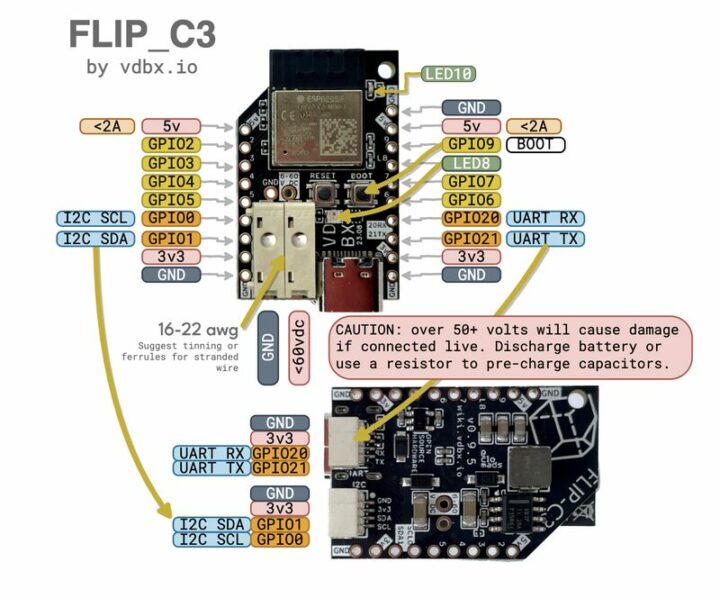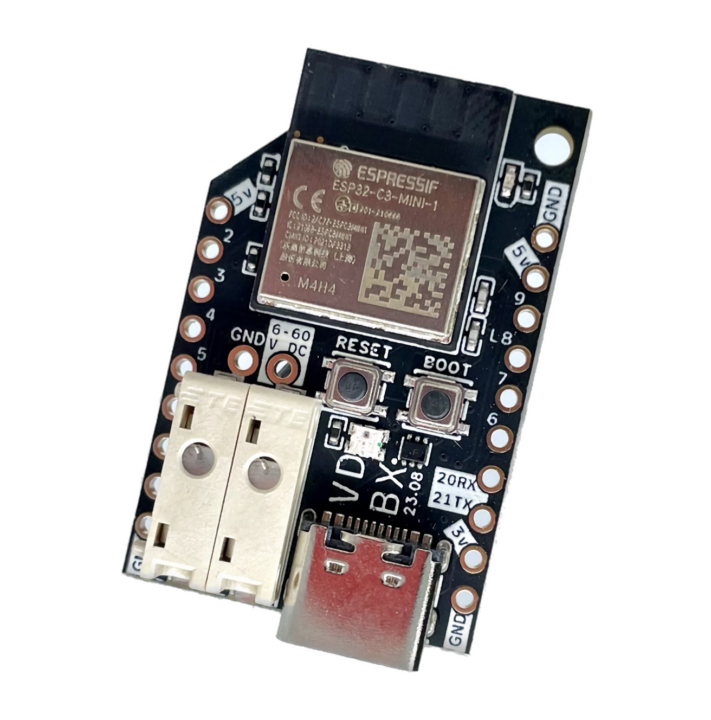Voidbox FLIP_C3 is an open-source hardware board powered by an ESP32-C3 WiFi & BLE microcontroller that takes up to 60V DC power input feeding a 5V/2A DC-DC step-down converter and flashed with ESPHome firmware by default for Home Assistant support.
The board incorporates a push-in spring release connector which means stranded (ferrules or tinning are suggested) and solid wires can be used in deploying the device in off-grid/battery-powered systems with up to 16s LiFePO4 delivering 48V through the 6-60V input port on the ESP32-C3 board. The onboard WS2812B LED can be used as a null pixel/level shifter for longer strings of addressable pixels.
The ESP32-C3 – due to its support for Wi-Fi and BLE connectivity – is a popular SoC for IoT solutions and powers home and industrial automation devices such as NanoCell v2.1, Spark Analyzer, LOLIN C3 Pico, and the LILYGO T-RSC3.
It is built for home automation applications and comes with ESPHome preloaded for easy integration with Home Assistant. However, it is easy to install other firmware such as Tasmota and WLED on the device via USB-C and over-the-air updates.
FLIP_C3 specifications:
- Microcontroller – ESP32-C3 RISC-V MCU @ 160 MHz, with Wi-Fi and BLE 5 connectivity pre-loaded with ESPHome for Home Assistant
- USB – USB-C for alternative power and programming; reverse current protection from DC input via diode
- Expansion
- I2C and UART on JST SH1.0 4-pin connectors compatible with Stemma QT and Qwiic modules
- 9-pin + 10-pin headers with GPIO, I2C, UART, 5V,. 3.3V, and GND
- Onboard LEDs
- WS2812B RGB LED with D-Out sent to L8 on pin header
- Status LED
- Buttons – Boot, Reset
- Onboard 5V/2A buck converter
- Power – Up to 10W (with cooling)
- Tolerant up to 50V DC for direct connection
- 60V absolute max (with pre-charge resistor)
- Push-in, spring terminal for DC input
- Solid: 24 – 16 AWG
- Stranded: 22 – 18 AWG
- 2x2P 2/54 pass-through power header for stacking
 Typical applications of the FLIP_C3 board include:
Typical applications of the FLIP_C3 board include:
- Deploying short runs of addressable LEDs using level-shifted output from WS2182B, and
- Reading Daly BMS data via UART and using the onboard buck converter to supply power from a 14s Li-ion or 16s LiFePo4 pack.
The board is open-source and hardware files are hosted on OSHWLab. A 3D DIN rail mount can be downloaded from printables.
The FLIP_C3 is available on Amazon and Tindie for $20. More information about the product and other VoidBox projects is available on the Voidbox wiki page.

Tomisin is a writer specializing in hardware product reviews, comparisons, and explainers. He is very passionate about small form factor and single-board computers.
Support CNX Software! Donate via cryptocurrencies, become a Patron on Patreon, or purchase goods on Amazon or Aliexpress





